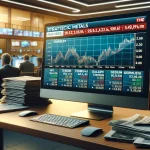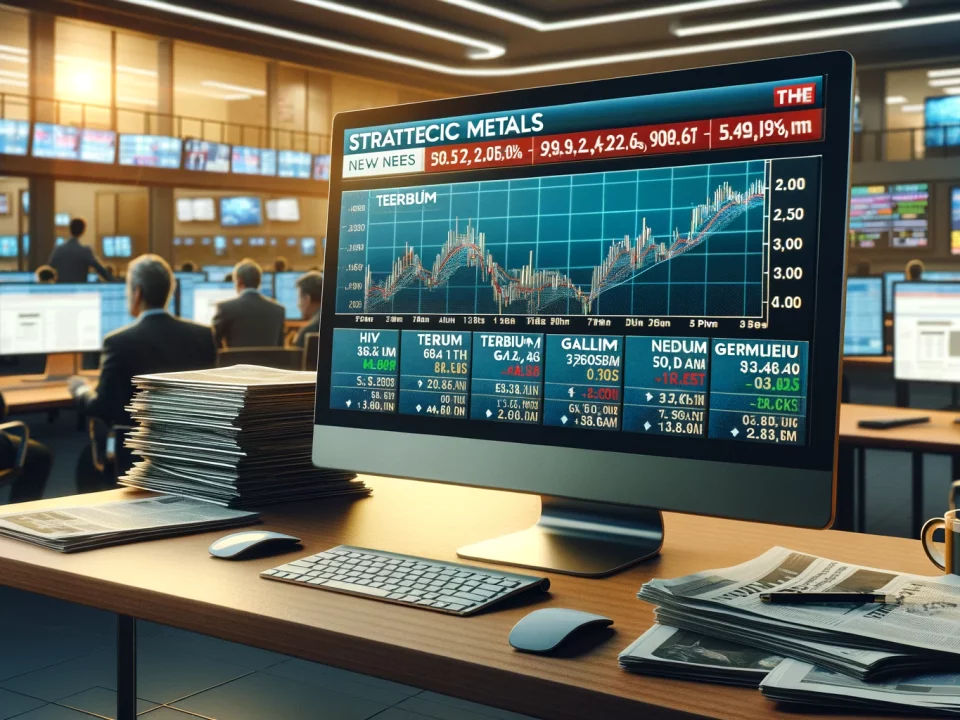
Weekly News Review July 7 – July 13 2025
July 13, 2025
Weekly News Review July 21 – July 27 2025
July 27, 2025Rare earth elements stood center stage again this week in the world of critical minerals. While the leading producer, China, published June export data, America’s largest rare earth miner, MP Materials, secured a $500 million deal with tech giant Apple.
All this and more from the newsroom in our weekly round-up.
CHINESE RARE EARTH EXPORTS RISE IN JUNE:
Chinese exports of rare earth elements surged in June. According to the latest data from the customs authorities, exports increased by 32 percent compared to the previous month, reaching 7,742 metric tons. Compared to last year, exports remain at an elevated level.
In April, Beijing imposed export controls for certain members of this group of elements, requiring licenses for the shipment of these elements. The lengthy approval process led to a complete halt in terbium exports in May, a critical component used in high-performance magnets, for example.
It remains to be seen whether exports of the rare earths affected by the measures recovered in June. The increase observed in May was mainly due to light rare earths, such as neodymium, which are not subject to trade restrictions. More detailed insights are expected in the coming weeks when customs authorities release more in-depth trade data.
KAZAKHSTAN REMOVES EXPORT DUTY ON GALLIUM:
According to media reports, Kazakhstan has removed its ten percent export duty on gallium. At the same time, it introduced an export ban on unprocessed non-ferrous metals, including copper, aluminum, and lead, which remains in effect through the end of this year. Both measures aim to support domestic production and processing of these raw materials, thereby increasing local value creation.
Gallium is used in semiconductor chips, LEDs, and military technology. Since China, the leading producer, introduced export restrictions two years ago, global shipments have dropped sharply and at times halted completely. Although Kazakhstan ceased its primary gallium production in 2013, according to the US Geological Survey, government officials claim the country still holds sufficient reserves to become a significant player in the global market.
Kazakhstan to Expand Production of Critical Raw Materials; Significant Investment Across the Entire Supply Chain Required:
The country’s ambition to make better use of its domestic resources is not a new one. In recent years, Kazakhstan has presented itself as a potential future supplier of rare earth elements. According to government sources, most known deposits of critical raw materials remain unexplored, and further international funding will be required (we reported).
Equally important will be investment in downstream processing. China not only dominates extraction but also controls a significant portion of the global refining capacity for key minerals. One crucial move may already be in progress. Just days ago, it was announced that mining group Eurasian Resources will invest $20 million in local gallium production facilities starting next year. The company plans to use bauxite ore, which it uses for alumina production. According to Eurasian Resources, this could position Kazakhstan as the second-largest gallium producer after China.
NEW MOMENTUM FOR RARE EARTHS IN WESTERN SUPPLY CHAIN:
Rare earths and China are often mentioned in the same breath. While the West has made some progress in producing light rare earth elements, such as neodymium, China remains dominant in the production and refinement of heavy rare earths, including terbium and dysprosium. The technical complexity of refining these elements means that capacity and know-how are still concentrated mainly in the People’s Republic. With China imposing strict export controls on most heavy rare earths, global supply has become even more constrained.
Against this backdrop, two Western producers have now reported key milestones along the heavy rare earth value chain. Australian Strategic Materials (ASM), a mining and processing company, has announced its first commercial sale of terbium and dysprosium to Neo Performance Materials, a Canadian supplier of advanced industrial materials. The feedstock was refined at ASM’s plant in South Korea and shipped to Neo’s magnet production facility in Estonia for further processing. The two companies have also announced plans to deepen their collaboration, including evaluating the potential supply of magnet materials from Neo to ASM.
Ucore Demonstrates Terbium-Dysprosium Separation:
Almost simultaneously, Ucore Rare Metals shared promising news. As reported back in May, the Canadian company is working with support from the US Department of Defense to bring its rare earth separation technology to commercial scale. According to Ucore, it has now successfully demonstrated the separation of terbium and dysprosium, a key technical milestone. The Pentagon recognized this achievement with a $1.1 million grant. Ucore currently operates a demonstration plant in Canada and plans to establish a full-scale production facility in the US state of Louisiana.
These advancements reflect a growing trend of supply chain diversification for heavy rare earths. Australian mining giant Lynas has recently become the first commercial producer of heavy rare earths outside of China. With funding support from the Pentagon, Lynas is building a separation plant for heavy rare earth elements in the United States.
Last week, the industry made headlines when it was announced that the US Department of Defense would become the largest shareholder in MP Materials, America’s leading producer of rare earth elements. The multi-billion-dollar investment aims to strengthen domestic processing capabilities, especially for heavy rare earth elements.
MAGNETS MADE IN USA: APPLE PARTNERS WITH MP MATERIALS –
MP Materials, the leading producer of rare earth elements in the United States, has announced a significant new partnership following recent backing from the US Department of Defense. The company will supply tech giant Apple with rare earth magnets, manufactured in Fort Worth, Texas, using recycled materials. The feedstock is sourced from used and industrial scrap magnets and processed at MP’s facility in Mountain Pass, California.
Apple and MP Materials have been collaborating for several years to develop the necessary technology for recycling and reusing rare earth materials. The supply agreement is valued at $500 million and represents a significant milestone in securing a domestic, sustainable rare earth supply chain.
Following the US government’s support, Apple’s involvement sends a powerful signal to the broader market, encouraging other companies to invest in rare earth value chains.
In a further boost to MP Materials’ ambitions, central investment banks Goldman Sachs and JPMorgan Chase have also pledged funding for the construction of the company’s magnet production facility.
GOLD PRICE EXPECTED TO BE STABLE IN H2 ACCORDING TO WORLD GOLD COUNCIL:
The World Gold Council expects gold prices to remain stable in the second half of the year, with only a few upside or downside risks and opportunities. The trade association, based in London, has published its Mid-Year Outlook for the precious metal, outlining potential events and a recap of the first half of 2025.
In the first half of the year, gold rose 26% in US dollar prices, setting 26 new all-time highs. According to the report, this performance was driven by a combination of factors, including a weaker US dollar, heightened geopolitical and trade tensions, high trading volumes, and robust demand from both central banks and exchange-traded funds (ETFs).
Central Bank Purchases to Cushion Possible Safe-Haven Appeal Cooling:
In the second half, however, fewer catalysts are expected to drive significant price swings. The Council notes that while geopolitical risks and macroeconomic uncertainties remain, they are less likely to escalate sharply from current levels. Additionally, interest rates are expected to remain steady, and inflation is likely to cool in several key economies, potentially cooling the safe-haven appeal. However, continued central bank purchases, particularly from emerging markets, are likely to prevent sharp price declines. Additionally, demand from retail and institutional investors is expected to remain resilient, especially if equity market volatility returns or global growth slows.
Besides gold, other precious metals, including silver and platinum, also recorded notable price jumps in the first half of the year. However, the drivers for these metals are different, as both serve not only as investment assets but also have substantial industrial demand. For instance, over half of global silver production is utilized in industries such as electronics, medicine, and solar energy.
US BASED ENERGY FUELS COMMENCES HEAVY RARE EARTH PRODUCTION:
U.S.-based critical minerals company Energy Fuels has started pilot-scale production of heavy rare earth element (HREE) oxides at its White Mesa Mill in Utah. The initial phase focuses on producing dysprosium, with terbium and samarium expected to follow shortly. Since April, all three elements have been subject to export controls from China, the world’s leading producer of these materials. In May, no shipments of dysprosium, terbium, or samarium cleared Chinese customs.
According to the company, Energy Fuels is now the only US company currently producing separated HREE oxides from mined commercial ores as opposed to using recycled feedstocks in other projects. Commercial production of the three elements could begin as early as late 2026, the company said.
In June, its co-owned Donald Rare Earth and Mineral Sands Project received the final regulatory approval (we reported). The company aims to eventually source the feedstock for its rare earth separation process at its White Mesa Mill from the project in Australia, as early as 2027, using existing feedstock in the meantime. The company is also advancing two other projects worldwide.
The Toliara Project in Madagascar is expected to be completed by 2028, pending approval from the government. The Bahia Project in Brazil is currently in the exploration and permitting stage and is expected to commence in 2029.
Given China’s imposed export controls, Western nations are scrambling to secure supply chains. Earlier this week, we reported on the latest developments.
JAPAN AND EUROPE TO COOPERATE IN THE PROCUREMENT OF RARE EARTHS:
Following the launch of an EU purchasing platform for critical raw materials, a bilateral partnership may follow to consolidate demand further and strengthen market leverage.
Japan and the EU are exploring options for joint procurement of rare earth elements to reduce their dependence on China, the world’s leading supplier of these elements. Public-private partnerships are expected to play a central role in this plan, according to a report published Thursday by Nikkei Asia.
The report also mentions the possibility of simplifying EU regulations. Details of the potential cooperation are expected to be discussed over the summer in meetings between foreign and economic ministers. The initiative is expected to be formally announced at the EU–Japan leaders’ summit on July 23.
Since China imposed export controls on certain rare earth elements and related products in April, the global supply situation has worsened. In May, exports of particularly critical components, such as terbium, dropped to zero.
Western countries have since intensified their efforts to reduce their dependency on raw materials. Just last week, we reported that the European Commission is developing measures to establish strategic stockpiles, which will also include critical raw materials. In addition, the supply of these and other strategic resources—such as hydrogen and natural gas—is to be facilitated through joint procurement among EU member states. A dedicated EU platform for this purpose was launched in early July.
Japan Seen as a Model for Resilient Supply Chains:
While the EU still has ground to make up, Japan is seen as a model for building resilient supply chains. Diversifying away from China has long been a strategic focus there. A key player is JOGMEC, the state-owned Japan Oil, Gas and Metals National Corporation, established over 20 years ago to enhance energy and resource security.
JOGMEC provides financial support for exploration and mining projects, including those overseas. So far, the EU has no comparable institution. Even the recently published draft budget for 2028-2034 contains no reference to such an initiative, despite repeated calls from industry representatives for increased investment in raw material value chains.
CHINA REFRAINS FROM PUBLISHING ITS RARE EARTH QUOTAS:
China has allocated its first annual quotas for rare earth mining and processing without the usual public announcement. Reuters reported this exclusively, citing informed sources, and sees it as another sign of Beijing’s increasing control over the sector. The actual figures were not disclosed to the news agency.
The quotas are usually granted twice a year to state-owned companies and are considered a barometer for the global supply situation. This year’s allocation was significantly delayed, according to Reuters, partly due to a February proposal to include imported ore in the quota system. This sparked resistance from companies reliant on imports to meet their raw material needs.
Over the past decades, China has gradually tightened its control over the rare earth industry. The sector has been consolidated into only a few key players. You can learn more about this topic in our background report.
FIGURE OF THE WEEK: – 71% – The percentage of newly installed renewable energy capacity worldwide in 2024 came from Asia, making it the global leader in expansion.






